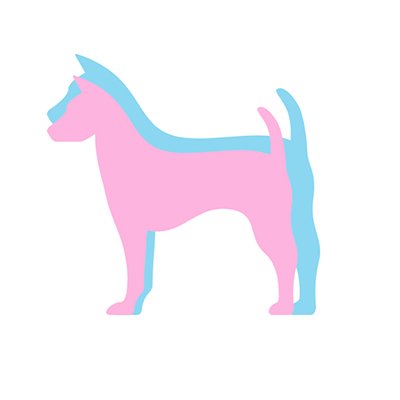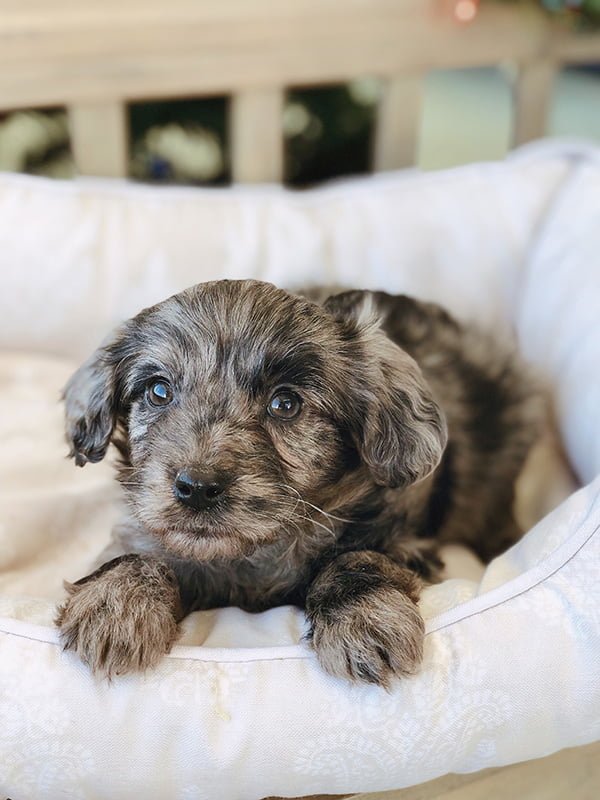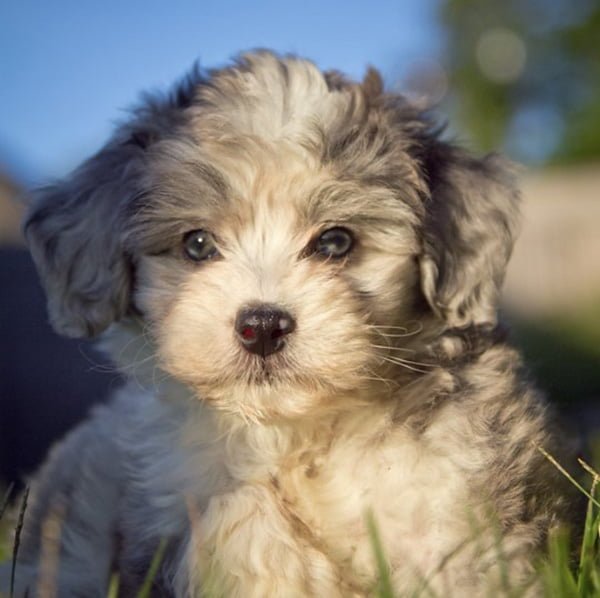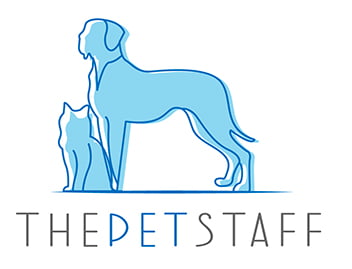Aussiedoodles are an adorable and intelligent breed of dog that is gaining in popularity for their great personalities and hypoallergenic properties. For dog owners who want one of these cute puppies but might be concerned that an Aussiedoodle is too big, there is now a miniature version of this lovable puppy: the mini Aussiedoodle.
Mini Aussiedoodles are on top of the list of popular designer dog breeds for good reasons, too. So, is the Mini Aussiedoodle the dog for you? Here is everything you need to know about this breed.
Breed Characteristics
Temperament | Affectionate, Playful, Intelligent, Energetic |
Intelligence | High |
Affection/Friendliness | High |
Trainability | High |
Mental Stimulation | Moderate to High |
Exercise Needs | Moderate to High |
Apartment Living | Can adapt to apartment living with sufficient exercise and mental stimulation |
Family Friendly | Yes |
Pet Friendly | Yes |
Drooling Level | Low to Moderate |
Energy Level | Medium to High |
Loneliness Tolerance | Low |
Adaptability | High |
Tendency to bark | Moderate to High |
Origin
The Mini Aussiedoodle is a designer dog hybrid of two purebred breeds. These breeds are a miniature poodle and a mini Australian shepherd. Miniature Australian shepherds and miniature poodles are purebred dogs created by dog breeders breeding the smallest dogs in each purebred litter of full-sized dogs to gradually create a smaller and smaller version of the full-sized dog. This is how you get a mini poodle and a miniature Australian shepherd.
Mini Aussiedoodles are a hybrid of these pure miniature breeds. The history of the Mini Aussiedoodle is not known specifically though it most likely began sometime in the 80s or 90s as poodle hybrids were gaining in popularity for their hypoallergenic properties. Mini aussiedoodles are also known as mini aussiepoos, miniature aussiedoodles, and miniature aussiepoos.
As a designer breed, Mini Aussiedoodles are not recognized by any of the major kennel clubs, and this is due to the breed's lack of predictability or a breed standard. However, they are recognized by a few hybrid or designer dog clubs, including the Canine Hybrid Club (ACHC) and the International Designer Dog Registry (IDCR).

Breed Overview
Height: 12-18"
Weight: 15-40 lbs
Height: 12-18"
Weight: 15-40 lbs
Breed Group
Not recognized as an official breed, but considered a designer breed
Life Span
12-15 years
Coat
Wavy or Curly
Coat Length
Medium
Hypoallergenic
It depends. Some individuals may be hypoallergenic, but it's not guaranteed.
Shedding Level
Low to Moderate
Size
Mini Aussiedoodles are medium size designer dogs. However, there is still a great deal of potential for variation among individuals. Dogs can grow to heights between 12 and 18 inches and weigh anywhere between 15 and 40 pounds.
Personality
Miniature Aussiedoodles have charming and bright personalities and are one of the many reasons they have become beloved pets. They are energetic, playful, smart, and loyal while also being loving, affectionate, gentle, and even a little sassy.
A Miniature Aussiedoodle puppy, however, can be a mystery. They don't have an equal balance of their parents' personalities, and they will most likely take strongly after one parent breed.
Appearance/Colors
Mini Aussiedoodles are given a lot of variety regarding potential coat types and colors because of the variety in the parent breeds. Most mini Aussiedoodles will have a medium-length coast of loose, wavy hair that is silky soft. They can come in a whole host of colorings given their parentage and can be solid, bicolored, tri-colored, or merle. Common colorations include white, red merle, blue merle, black, silver, grey, and black and white.

Source: Flickr
Aussiedoodle eyes are also subject to a great deal of variety due to the Australian Shepherd genes and can be brown, green, hazel, or amber. A Mini Aussiedoodle can get stunning blue eyes if the merle gene is present. Some Mini Aussiedoodles will get two eyes that are different colors.
Temperament
Miniature Aussiedoodles have excellent temperaments, both energetic and loving. They are great family dogs and get along very well with kids and other dogs and pets.
As a poodle hybrid, Mini Aussiedoodle is hypoallergenic and makes great pets for dog lovers who are sensitive to dog allergies.
Mini Aussiedoodle is a very friendly and cheerful dog and gets along well with people of all ages. They are very loving and affectionate and love to stay by your side as long as their needs are met. They may tend to herd, which can be great in a cat household.
Diet/Nutritional Needs
A Miniature Aussiedoodle should be fed a diet formulated for active medium-sized breeds. As a dog prone to weight gain, it is important to feed your dog measured meals 2-3 times during the day rather than letting your dog have free access to food at all times. Consult with your vet to determine the correct amount and type of food your pup needs. Your vet can make a recommendation based on your dog's age, weight, health, and activity levels to ensure that your Aussiedoodle doesn't become overweight.
Activity/Exercise Needs
The Mini Aussiedoodle is a high-activity dog and will need a lot of exercise to stay in shape and happy. Aside from physical stimulation, mental stimulation is also important for this breed.
Mini Aussiedoodle is not a dog breed for low-activity homes or owners who cannot include their dogs in their everyday lives. A Mini Aussiedoodle needs between 30 and 60 minutes of exercise a day, some portion of that being high intensity.
Aussiedoodles enjoy walks, jogs, hiking, and dog sports. They can excel in agility and track training but also love a romp in a large, safely enclosed yard. They do tend to wander, so they should remain on a leash unless they are in a securely fenced-in area. Some Mini Aussiedoodles enjoy water sports, though this varies between individual dogs. Including your pup in daily activities and business is a great way to keep them healthy, happy, relaxed, and calm at the end of the day.
Grooming Needs
Although the Mini Aussiedoodle is a low-shedding hybrid dog breed, it still requires a commitment to grooming to maintain its coat. Mini Aussiedoodles should be brushed 2-3 times a week and professionally groomed and trimmed every 3-4 months.
Ears should be inspected regularly for irritation or infection, and nails should be kept short with regular trimmings as needed. To prevent any dental disease, it's best to brush your dog's teeth regularly with a dog toothbrush and toothpaste formulated for dogs.
Adaptability
As a small dog with a very amiable personality, a Mini Aussiedoodle is an adaptable pet that can thrive in a variety of home situations. They make great apartment dogs if they get sufficient exercise outside their homes. They are small and quiet and do well in apartment living. However, this breed does not tolerate being left alone very well and will also run into trouble if not exercised adequately. They are not high barkers but may resort to vocalizations and destructive behaviors if they get bored or anxious.
These dogs get along very well with kids and are gentle and careful, even with small children and smaller pets. With early socialization and training, they will live peacefully with just about anyone.

Source: Flickr
The trainability of a Mini Aussiedoodle Puppy
The Mini Aussiedoodle is an incredibly bright and highly intelligent dog, as both the Australian Shepherd and Poodle are two of the smartest breeds in the canine world. This dog is super intelligent and loves to please, making it a relatively easy puppy to train.
Mini Aussiedoodle puppies learn fast and will learn best with positive reinforcement and a rewards-based training schedule. Training should begin as early as possible to instill good habits from a young age and to prevent bad habits from setting in.
It is equally important to socialize Miniature Aussiedoodle puppies to ensure they know how to get along well in public and behave politely in various situations without becoming stressed.
Life Expectancy
A healthy, cared-for Mini Aussiedoodle has a life expectancy of 11-15 years.
Potential Health Issues
As a designer dog breed and a hybrid of other purebred dogs, Mini Aussiedoodles bypass a lot of possible genetic or hereditary conditions that often affect the purebred dog. Therefore, when it comes to Mini Aussiedoodle breeders, you will need to do your homework.
Otherwise, these are relatively healthy dogs and have far fewer health issues. The conditions that might affect a Mini Aussiedoodle are related to them that they might inherit from either parent breed.
Hip Dysplasia
Hip dysplasia is a genetic condition that results in the malformation of a dog's joints as it grows. It can be screened for in puppyhood, but little can be done to prevent it. Medications can be used to manage any pain throughout your dog's life.
Hypothyroidism
This is the thyroid malfunction that affects metabolic function and leads to several other issues. Dogs with hypothyroidism may struggle with weight gain and will also have skin and hair issues.
Von Willebrand's Disease
Von Willebrand's disease is a condition that affects the blood's ability to clot. This heredity condition cannot be cured, but symptoms can be managed.
